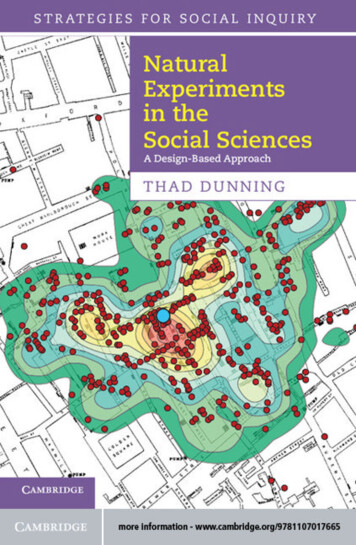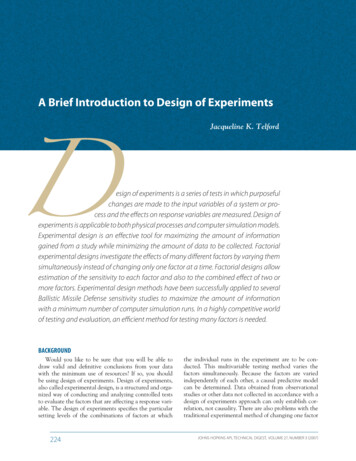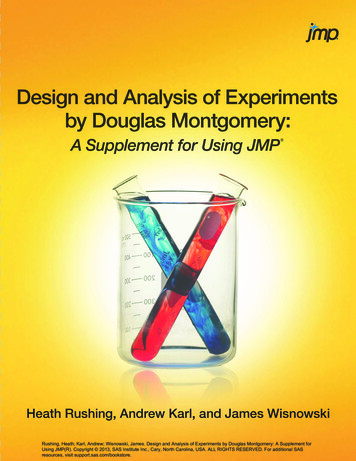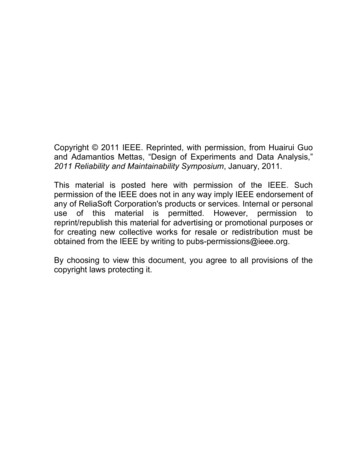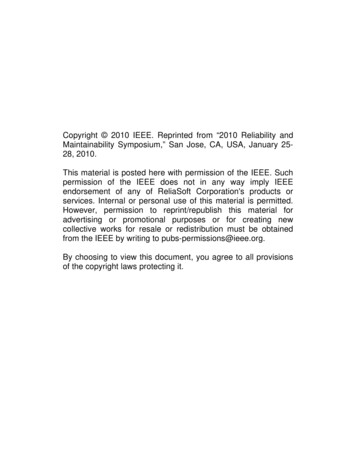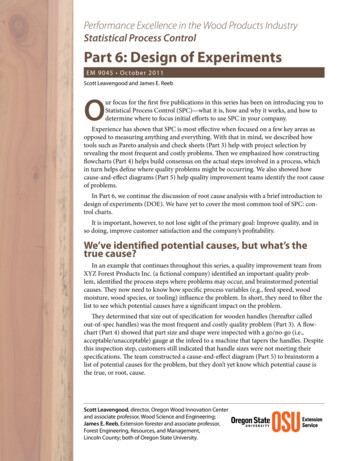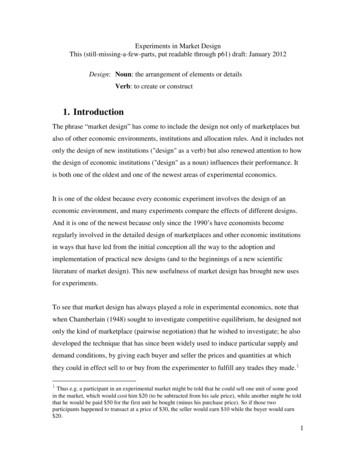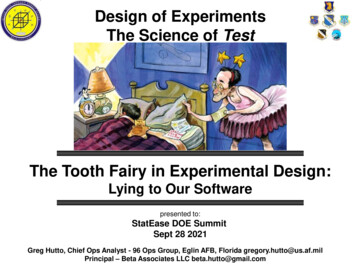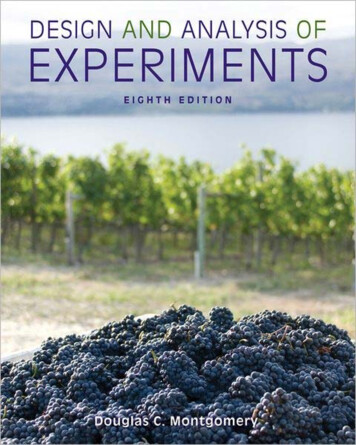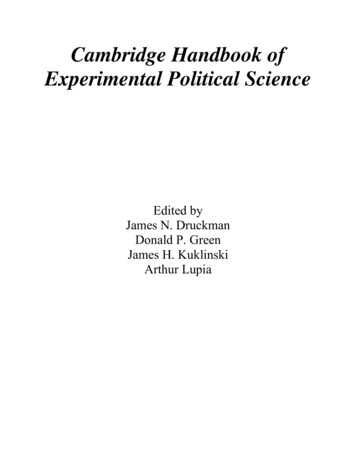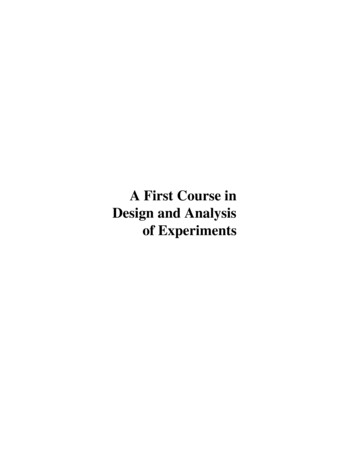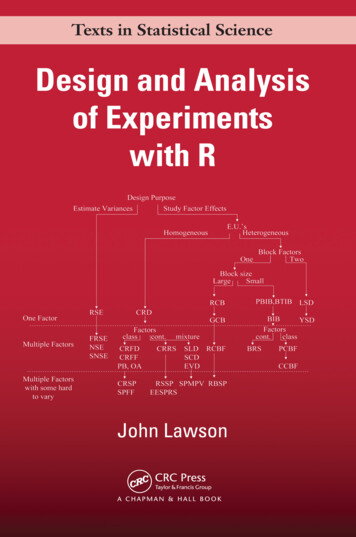
Transcription
Design and Analysisof Experimentswith R
CHAPMAN & HALL/CRCTexts in Statistical Science SeriesSeries EditorsFrancesca Dominici, Harvard School of Public Health, USAJulian J. Faraway, University of Bath, UKMartin Tanner, Northwestern University, USAJim Zidek, University of British Columbia, CanadaStatistical Theory: A Concise IntroductionF. Abramovich and Y. RitovPractical Multivariate Analysis, Fifth EditionA. Afifi, S. May, and V.A. ClarkPractical Statistics for Medical ResearchD.G. AltmanInterpreting Data: A First Coursein StatisticsA.J.B. AndersonIntroduction to Probability with RK. BaclawskiLinear Algebra and Matrix Analysis forStatisticsS. Banerjee and A. RoyAnalysis of Categorical Data with RC. R. Bilder and T. M. LoughinStatistical Methods for SPC and TQMD. BissellIntroduction to ProbabilityJ. K. Blitzstein and J. HwangBayesian Methods for Data Analysis,Third EditionB.P. Carlin and T.A. LouisSecond EditionR. CaulcuttThe Analysis of Time Series: An Introduction,Sixth EditionC. ChatfieldIntroduction to Multivariate AnalysisC. Chatfield and A.J. CollinsProblem Solving: A Statistician’s Guide,Second EditionC. ChatfieldStatistics for Technology: A Course in AppliedStatistics, Third EditionC. ChatfieldBayesian Ideas and Data Analysis: AnIntroduction for Scientists and StatisticiansR. Christensen, W. Johnson, A. Branscum,and T.E. HansonModelling Binary Data, Second EditionD. CollettModelling Survival Data in Medical Research,Third EditionD. CollettIntroduction to Statistical Methods forClinical TrialsT.D. Cook and D.L. DeMetsApplied Statistics: Principles and ExamplesD.R. Cox and E.J. SnellMultivariate Survival Analysis and CompetingRisksM. CrowderStatistical Analysis of Reliability DataM.J. Crowder, A.C. Kimber,T.J. Sweeting, and R.L. SmithAn Introduction to GeneralizedLinear Models, Third EditionA.J. Dobson and A.G. BarnettNonlinear Time Series: Theory, Methods, andApplications with R ExamplesR. Douc, E. Moulines, and D.S. StofferIntroduction to Optimization Methods andTheir Applications in StatisticsB.S. EverittExtending the Linear Model with R:Generalized Linear, Mixed Effects andNonparametric Regression ModelsJ.J. FarawayLinear Models with R, Second EditionJ.J. FarawayA Course in Large Sample TheoryT.S. FergusonMultivariate Statistics: A PracticalApproachB. Flury and H. RiedwylReadings in Decision AnalysisS. French
Markov Chain Monte Carlo:Stochastic Simulation for Bayesian Inference,Second EditionD. Gamerman and H.F. LopesBayesian Data Analysis, Third EditionA. Gelman, J.B. Carlin, H.S. Stern, D.B. Dunson,A. Vehtari, and D.B. RubinMultivariate Analysis of Variance andRepeated Measures: A Practical Approach forBehavioural ScientistsD.J. Hand and C.C. TaylorPractical Longitudinal Data AnalysisD.J. Hand and M. CrowderLogistic Regression ModelsJ.M. HilbeRichly Parameterized Linear Models:Additive, Time Series, and Spatial ModelsUsing Random EffectsJ.S. HodgesStatistics for EpidemiologyN.P. JewellStochastic Processes: An Introduction,Second EditionP.W. Jones and P. SmithThe Theory of Linear ModelsB. JørgensenPrinciples of UncertaintyJ.B. KadaneGraphics for Statistics and Data Analysis with RK.J. KeenMathematical StatisticsK. KnightIntroduction to Multivariate Analysis:Linear and Nonlinear ModelingS. KonishiNonparametric Methods in Statistics with SASApplicationsO. KorostelevaModeling and Analysis of Stochastic Systems,Second EditionV.G. KulkarniExercises and Solutions in Biostatistical TheoryL.L. Kupper, B.H. Neelon, and S.M. O’BrienExercises and Solutions in Statistical TheoryL.L. Kupper, B.H. Neelon, and S.M. O’BrienDesign and Analysis of Experiments with RJ. LawsonDesign and Analysis of Experiments with SASJ. LawsonA Course in Categorical Data AnalysisT. LeonardStatistics for AccountantsS. LetchfordIntroduction to the Theory of StatisticalInferenceH. Liero and S. ZwanzigStatistical Theory, Fourth EditionB.W. LindgrenStationary Stochastic Processes: Theory andApplicationsG. LindgrenThe BUGS Book: A Practical Introduction toBayesian AnalysisD. Lunn, C. Jackson, N. Best, A. Thomas, andD. SpiegelhalterIntroduction to General and GeneralizedLinear ModelsH. Madsen and P. ThyregodTime Series AnalysisH. MadsenPólya Urn ModelsH. MahmoudRandomization, Bootstrap and Monte CarloMethods in Biology, Third EditionB.F.J. ManlyIntroduction to Randomized ControlledClinical Trials, Second EditionJ.N.S. MatthewsStatistical Methods in Agriculture andExperimental Biology, Second EditionR. Mead, R.N. Curnow, and A.M. HastedStatistics in Engineering: A Practical ApproachA.V. MetcalfeStatistical Inference: An Integrated Approach,Second EditionH. S. Migon, D. Gamerman, andF. LouzadaBeyond ANOVA: Basics of Applied StatisticsR.G. Miller, Jr.A Primer on Linear ModelsJ.F. MonahanApplied Stochastic Modelling, Second EditionB.J.T. MorganElements of SimulationB.J.T. Morgan
Probability: Methods and MeasurementA. O’HaganIntroduction to Statistical Limit TheoryA.M. PolanskyApplied Bayesian Forecasting and Time SeriesAnalysisA. Pole, M. West, and J. HarrisonStatistics in Research and Development,Time Series: Modeling, Computation, andInferenceR. Prado and M. WestIntroduction to Statistical Process ControlP. QiuSampling Methodologies with ApplicationsP.S.R.S. RaoA First Course in Linear Model TheoryN. Ravishanker and D.K. DeyEssential Statistics, Fourth EditionD.A.G. ReesStochastic Modeling and MathematicalStatistics: A Text for Statisticians andQuantitative ScientistsF.J. SamaniegoStatistical Methods for Spatial Data AnalysisO. Schabenberger and C.A. GotwayBayesian Networks: With Examples in RM. Scutari and J.-B. DenisLarge Sample Methods in StatisticsP.K. Sen and J. da Motta SingerDecision Analysis: A Bayesian ApproachJ.Q. SmithAnalysis of Failure and Survival DataP. J. SmithApplied Statistics: Handbook of GENSTATAnalysesE.J. Snell and H. SimpsonApplied Nonparametric Statistical Methods,Fourth EditionP. Sprent and N.C. SmeetonData Driven Statistical MethodsP. SprentGeneralized Linear Mixed Models:Modern Concepts, Methods and ApplicationsW. W. StroupSurvival Analysis Using S: Analysis ofTime-to-Event DataM. Tableman and J.S. KimApplied Categorical and Count Data AnalysisW. Tang, H. He, and X.M. TuElementary Applications of Probability Theory,Second EditionH.C. TuckwellIntroduction to Statistical Inference and ItsApplications with RM.W. TrossetUnderstanding Advanced Statistical MethodsP.H. Westfall and K.S.S. HenningStatistical Process Control: Theory andPractice, Third EditionG.B. Wetherill and D.W. BrownGeneralized Additive Models:An Introduction with RS. WoodEpidemiology: Study Design andData Analysis, Third EditionM. WoodwardPractical Data Analysis for DesignedExperimentsB.S. Yandell
Texts in Statistical ScienceDesign and Analysisof Experimentswith RJohn LawsonBrigham Young UniversityProvo, Utah, USA
CRC PressTaylor & Francis Group6000 Broken Sound Parkway NW, Suite 300Boca Raton, FL 33487-2742 2015 by Taylor & Francis Group, LLCCRC Press is an imprint of Taylor & Francis Group, an Informa businessNo claim to original U.S. Government worksVersion Date: 20150406International Standard Book Number-13: 978-1-4987-2848-5 (eBook - PDF)This book contains information obtained from authentic and highly regarded sources. Reasonable effortshave been made to publish reliable data and information, but the author and publisher cannot assumeresponsibility for the validity of all materials or the consequences of their use. The authors and publishershave attempted to trace the copyright holders of all material reproduced in this publication and apologize tocopyright holders if permission to publish in this form has not been obtained. If any copyright material hasnot been acknowledged please write and let us know so we may rectify in any future reprint.Except as permitted under U.S. Copyright Law, no part of this book may be reprinted, reproduced, transmitted, or utilized in any form by any electronic, mechanical, or other means, now known or hereafter invented,including photocopying, microfilming, and recording, or in any information storage or retrieval system,without written permission from the publishers.For permission to photocopy or use material electronically from this work, please access www.copyright.com (http://www.copyright.com/) or contact the Copyright Clearance Center, Inc. (CCC), 222 RosewoodDrive, Danvers, MA 01923, 978-750-8400. CCC is a not-for-profit organization that provides licenses andregistration for a variety of users. For organizations that have been granted a photocopy license by the CCC,a separate system of payment has been arranged.Trademark Notice: Product or corporate names may be trademarks or registered trademarks, and are usedonly for identification and explanation without intent to infringe.Visit the Taylor & Francis Web site athttp://www.taylorandfrancis.comand the CRC Press Web site athttp://www.crcpress.com
ContentsPrefacexiList of Examplesxv1 Introduction1.1Statistics and Data Collection1.2Beginnings of Statistically Planned Experiments1.3Definitions and Preliminaries1.4Purposes of Experimental Design1.5Types of Experimental Designs1.6Planning Experiments1.7Performing the Experiments1.8Use of R Software1.9Review of Important Concepts1.10 Exercises112256791212152 Completely Randomized Designs with One Factor2.1Introduction2.2Replication and Randomization2.3A Historical Example2.4Linear Model for CRD2.5Verifying Assumptions of the Linear Model2.6Analysis Strategies When Assumptions Are Violated2.7Determining the Number of Replicates2.8Comparison of Treatments after the F -test2.9Review of Important Concepts2.10 Exercises17171719202931384149513 Factorial Designs3.1Introduction3.2Classical One at a Time versus Factorial Plans3.3Interpreting Interactions3.4Creating a Two-Factor Factorial Plan in R3.5Analysis of a Two-Factor Factorial in R3.6Factorial Designs with Multiple Factors—CRFD3.7Two-Level Factorials5555555760618085vii
viiiCONTENTS3.83.93.10Verifying Assumptions of the ModelReview of Important ConceptsExercises1021061084 Randomized Block Designs4.1Introduction4.2Creating an RCB in R4.3Model for RCB4.4An Example of an RCB4.5Determining the Number of Blocks4.6Factorial Designs in Blocks4.7Generalized Complete Block Design4.8Two Block Factors LSD4.9Review of Important Concepts4.10 Exercises4.11 Appendix—Data from the Golf Experiment1131131141161171211221241281331351405 Designs to Study Variances5.1Introduction5.2Random Factors and Random Sampling Experiments5.3One-Factor Sampling Designs5.4Estimating Variance Components5.5Two-Factor Sampling Designs5.6Nested Sampling Experiments (NSE)5.7Staggered Nested Designs5.8Designs with Fixed and Random Factors5.9Graphical Methods to Check Model Assumptions5.10 Review of Important Concepts5.11 Exercises1411411421441451551641671731801881906 Fractional Factorial Designs1936.1Introduction1936.2Half-Fractions of 2k Designs1946.3Quarter and Higher Fractions of 2k Designs2046.4Criteria for Choosing Generators for 2k p Designs2066.5Augmenting Fractional Factorials2186.6Plackett-Burman (PB) and Model Robust Screening Designs 2296.7Mixed Level Factorials and Orthogonal Arrays (OAs)2426.8Definitive Screening Designs2486.9Review of Important Concepts2506.10 Exercises2527 Incomplete and Confounded Block Designs7.1Introduction7.2Balanced Incomplete Block (BIB) Designs261261262
CONTENTS7.37.47.57.67.77.87.97.107.11Analysis of Incomplete Block DesignsBTIB and PBIB DesignsRow Column DesignsConfounded 2k and 2k p DesignsConfounding 3-Level and p-Level Factorial DesignsBlocking Mixed Level Factorials and OAsPartially Confounded Blocked Factorial (PCBF)Review of Important ConceptsExercisesix2642672712722852872953003038 Split-Plot Designs8.1Introduction8.2Split-Plot Experiments with CRD in Whole Plots CRSP8.3RCB in Whole Plots RBSP8.4Analysis Unreplicated 2k Split-Plot Designs8.52k p Fractional Factorials in Split Plots (SPFFs)8.6Sample Size and Power Issues for Split-Plot Designs8.7Review of Important Concepts8.8Exercises3073073083153233283413433459 Crossover and Repeated Measures Designs9.1Introduction9.2Crossover Designs (CODs)9.3Simple AB, BA Crossover Designs for Two Treatments9.4Crossover Designs for Multiple Treatments9.5Repeated Measures Designs9.6Univariate Analysis of Repeated Measures Designs9.7Review of Important Concepts9.8Exercises35135135135236136636837737910 Response Surface Designs10.1 Introduction10.2 Fundamentals of Response Surface Methodology10.3 Standard Designs for Second Order Models10.4 Creating Standard Response Surface Designs in R10.5 Non-Standard Response Surface Designs10.6 Fitting the Response Surface Model with R10.7 Determining Optimum Operating Conditions10.8 Blocked Response Surface (BRS) Designs10.9 Response Surface Split-Plot (RSSP) Designs10.10 Review of Important Concepts10.11 Exercises38338338338739640040741342643043944111 Mixture Experiments11.1 Introduction447447
1Models and Designs for Mixture ExperimentsCreating Mixture Designs in RAnalysis of Mixture ExperimentsConstrained Mixture ExperimentsBlocking Mixture ExperimentsMixture Experiments with Process VariablesMixture Experiments in Split-Plot ArrangementsReview of Important ConceptsExercisesAppendix—Example of Fitting Independent Factors44945645846447347848749149350112 Robust Parameter Design Experiments12.1 Introduction12.2 Noise Sources of Functional Variation12.3 Product Array Parameter Design Experiments12.4 Analysis of Product Array Experiments12.5 Single-Array Parameter Design Experiments12.6 Joint Modeling of Mean and Dispersion Effects12.7 Review of Important Concepts12.8 Exercises50350350450651453254054754913 Experimental Strategies for Increasing Knowledge13.1 Introduction13.2 Sequential Experimentation13.3 One-Step Screening and Optimization13.4 An Example of Sequential Experimentation13.5 Evolutionary Operation13.6 Concluding Remarks557557557561562567569Appendix—Brief Introduction to R571Answers to Selected Exercises573Bibliography577Index593
PrefaceAfter studying experimental design a researcher or statistician should be ableto: (1) choose an experimental design that is appropriate for the researchproblem at hand; (2) construct the design (including performing proper randomization and determining the required number of replicates); (3) executethe plan to collect the data (or advise a colleague on how to do it); (4) determine the model appropriate for the data; (5) fit the model to the data; and(6) interpret the data and present the results in a meaningful way to answerthe research question. The purpose of this book is to focus on connecting theobjectives of research to the type of experimental design required, describingthe actual process of creating the design and collecting the data, showing howto perform the proper analysis of the data, and illustrating the interpretation of results. Exposition on the mechanics of computation is minimized byrelying on a statistical software package.With the availability of modern statistical computing packages, the analysis of data has become much easier and is well covered in statistical methodsbooks. In a book on the design and analysis of experiments, there is no longera need to show all the computational formulas that were necessary before theadvent of modern computing. However, there is a need for careful explanationof how to get the proper analysis from a computer package. The default analysis performed by most statistical software assumes the data have come froma completely randomized design. In practice, this is often a false assumption.This book emphasizes the connection between the experimental units, and theway treatments are randomized to experimental units, and the proper errorterm for an analysis of the data.R is used throughout the book to illustrate both construction of experimental designs and analysis of data. R was chosen to be illustrated in the bookbecause it is an open-source software that can be downloaded free of charge forWindows, Linux, and Macintosh operating systems from www.r-project.org.Additionally, user developed packages for R have given it extensive capabilitiesin both creating experimental designs and analyzing data. Information aboutmany of these user written packages is available on the Web site sign.html that is maintainedby Ulrike Groemping. User written packages along with base R functionality are illustrated in many examples in the text. The packages simplify thingsthat could require extensive R coding without their use. The code examplesin the book are available for download on the Web site www.jlawson.byu.eduand they duplicate all design creation and data analysis methods illustratedxi
xiiPREFACEin the earlier version of this book, Design and Analysis of Experiments withSAS. These two books are very similar with the exception of the softwareillustrated. Therefore an instructor could conceivably teach a class on designand analysis of experiments while allowing his students to use either bookdepending upon which software package they prefer. In the future, it is possible that some of the R packages illustrated in this book may be removedfrom CRAN, if the developer drops support, or they may be changed by thedeveloper so that the examples in the book no longer work. If problems suchas this arise, revisions will be made to the code online so that a working copyof the examples is available.With fewer pages devoted to computational formulas, I have attempted tospend more time discussing the following: (1) how the objectives of a researchproject lead to the choice of an appropriate design, (2) practical aspects ofcreating a design or list of experiments to be performed, (3) practical aspectsof performing experiments, and (4) interpretation of the results of a computeranalysis of the data. Items (1)–(3) can best be taught by giving many examplesof experiments and exercises that actually require readers to perform their ownexperiments.This book attempts to give uniform coverage to experimental designs anddesign concepts that are most commonly used in practice, rather than focusingon specialized areas. The selection of topics is based on my own experienceworking in the pharmaceutical industry, and in research and development(R&D) and manufacturing in agricultural and industrial chemicals, and machinery industries. At the end of each chapter a diagram is presented to helpidentify where the various designs should be used. Examples in the book comefrom a variety of application areas. Emphasis is placed on how the samplesize, the assignment of experimental units to combinations of treatment factor levels (error control), and the selection of treatment factor combinations(treatment design) will affect the resulting variance and bias of estimates andthe validity of conclusions.Intended audience: This book was written for first- or second-year graduate students in statistics or advanced undergraduates who intend to work inan area where they will use experimental designs. To be fully understood, astudent using this book should have had previous courses in calculus, introductory statistics, basic statistical theory, and applied linear models such asKutner et al. (2004) and Faraway (2004). Matrix notation for analysis of linearmodels is used throughout the book, and students should be familiar with matrix operations at least to the degree illustrated in chapter 5 of Kutner et al.(2004). Also some experience with R or command driven statistical softwareis assumed, although there is a brief appendix and additional references forstudents with no experience with R.However, for students from applied sciences or engineering who do not haveall these prerequisites, there is still much to be gained from this book. Thereare many examples of diagnosing the experimental environment to choosethe correct design, creating the design, analyzing data, and interpreting and
PREFACExiiipresenting results of analysis. There is R code to create and analyze all theexample experiments in the book. One with a basic understanding of R, andaid of the documentation for the R functions illustrated, should be able tofollow these examples and modify them to complete the exercises in the bookand solve problems in their own research without needing to understand thedetailed theoretical justification for each procedure.For instructors: This book can be used for a one-semester or two-quartercourse in experimental design. There is too much material for a one-semestercourse, unless the students have had all the prerequisites mentioned above.The first four chapters in the book cover the classical ideas in experimentaldesign, and should be covered in any course for students without a priorbackground in designed experiments. Later chapters start with basics, butproceed to the latest research published on particular topics, and they includecode to implement all of these ideas. An instructor can pick and choose fromthese remaining topics, although if there is time to cover the whole book, Iwould recommend presenting the topics in order.Some instructors who do not intend to cover the entire book might considercovering factorial experiments in Chapter 3, fractional factorials in Chapter 6,and response surface methods in Chapter 10, following the pattern establishedby the DuPont Strategies of Experimentation Short Courses that were developed in the 1970s. I chose the ordering of chapters in the book so that variancecomponent designs in Chapter 5 would be presented before describing splitplot experiments that are so commonplace in practice. I did this because I feelit is important to understand random factors before studying designs wherethere is more than one error term.Acknowledgments: This book is the culmination of many years of thoughtprompted by consulting and teaching. I would be remiss if I did not thank thelate Melvin Carter, my advisor at Brigham Young University (BYU) who introduced me to the computer analysis of experimental data over 40 years ago,and whose enthusiasm about the subject of designed experiments inspired mylifelong interest in this area. I would also like to thank John Erjavec, my bossand mentor at FMC Corp., for introducing me to the ideas of Box, Hunter,and Hunter long before their original book Statistics for Experimenters waspublished. I also thank the many consulting clients over the years who havechallenged me with interesting problems, and the many students who haveasked me to explain things more clearly. Special thanks to my former studentsWillis Jensen at Gore and Michael Joner at Procter & Gamble for their carefulreview and comments on the first version of this book, to Ulrike Groempingat Beuth University of Applied Sciences Berlin for her careful review of themanuscript and R-code, and finally to the developers of the many packagesfor R that are illustrated in this book. Finally, I thank my wife Francesca forher never-ending support and encouragement during the writing of this book.John LawsonDepartment of StatisticsBrigham Young University
This page intentionally left blank
List of Examples1. Page 18 - Example of creating a completely randomized list of experimentsfor a bread dough rise experiment using base R commands, and storing itin an electronic data collection form.2. Page 23 - Calculation of least squares estimates from the bread dough riseexperiment using R function lm.3. Page 25 - Calculation of an estimable contrast of cell means from the breaddough rise experiment using the function fit.contrast from the R packagegmodels.4. Page 27 - ANOVA table for bread dough rise experiment using R functionaov.5. Page 29 - Creating graphs to verify the assumptions of the linear model fitto the bread dough rise experiment using R.6. Page 32 - R code to produce a Box-Cox plot for the bread dough riseexperiment.7. Page 33 - Analysis of transformed data for the bread dough rise experimentusing R.8. Page 35 - Weighted least squares analysis of data from the bread doughrise experiment using R.9. Page 37 - Generalized linear model fit to multinomial response data froma teaching experiment using the polr function in R package MASS.10. Page 40 - Power calculation for CRD model using R.11. Page 42 - Preplanned orthogonal comparisons using the functionfit.contrast from the R package gmodels for data from the 1937 Rothamstead field experiment with sugar beets.12. Page 43 - Preplanned orthogonal polynomial contrasts for linear andquadratic trends in the bread dough rise experiment using R.13. Page 44 - Tukey’s HSD multiple comparisons for data from the Rothamstead sugar beet experiment using R.14. Page 45 - Student Newman-Keuls multiple comparisons for data from theRothamstead sugar beet experiment using the SNK.test function in R package agricolae.15. Page 47 - Dunnett’s multiple comparisons for data from the Rothamsteadsugar beet experiment using the glht function in R package multcomp.xv
xviLIST OF EXAMPLES16. Page 48 - Hsu’s MCB multiple comparisons with the best using the glhtfunction in R package multcomp.17. Page 60 - Creating a randomized factorial plan in R for helicopter experiments.18. Page 65 - Analysis of a two-factor ANOVA of Hunter’s CO emission datausing R function aov.19. Page 71 - Power calculation for the two-factor factorial model using R.20. Page 74 - Analysis of a two-factor ANOVA of Hunter’s CO emission data(with an unequal number of observations per cell) using function Anovafrom the R package car.21. Page 77 - Analysis of an unreplicated two-factor factorial with quantitativelevels of the factors using R.22. Page 80 - Analysis of an unreplicated two-factor factorial with qualitativelevels of the factors using the Tukey1df function in R package daewr.23. Page 83 - Analysis of a four-factor factorial with a binomial response.24. Page 91 - Analysis of a 23 design using R.25. Page 97 - Analysis of an unreplicated 24 design using the fullnormalfunction in R package daewr.26. Page 99 - Analysis of an unreplicated 24 design using a half-normal plotwith the LGB function in the daewr package.27. Page 100 - Making an interaction plot with R.28. Page 101 - Making Lenth and Bayes plots of effects using the BsMD package.29. Page 103 - Detecting a single outlier in an unreplicated 2k design using theGaptest function in R package daewr.30. Page 115 - Creating an RCB design with R.31. Page 115 - Using the function design.rcbd in R package agricolae tocreate an RCB design with R.32. Page 118 - Analysis of an RCB design on the behavior of rats with R.33. Page 121 - Determining the number of blocks in an RCB design with R.34. Page 123 - Analysis of a factorial design in blocks using R.35. Page 124 - Example of a generalized complete block design.36. Page 130 - Example of creating a Latin-square design using the design.lsdfunction in R package agricolae.37. Page 131 - Analysis of a Latin-square design in R.38. Page 147 - Estimating variance components in a one-factor RSE using themethod of moments with R.39. Page 148 - Calculating a confidence interval for variance components in aone-factor RSE.40. Page 152 - Estimating variance components in a one-factor RSE by REMLusing the lmer function in R package lme4.
LIST OF EXAMPLESxvii41. Page 153 - Asymptotic confidence interval for a variance component usingthe likelihood profile method using the profile function in R packagelme4a.42. Page 154 - Determining the sample size for a one-factor RSE with R.43. Page 158 - Estimating the variance components for a two-factor RSE usingthe method of moments with R.44. Page 159 - Estimating the variance components for a two-factor RSE byREML using the lmer function in R package lme4.45. Page 160 - Calculating a confidence interval for variance components in atwo-factor RSE.46. Page 163 - Estimating the variance components for an unbalanced twofactor RSE using the lmer function in R package lme4.47. Page 164 - Calculating a confidence interval for variance components in anunbalanced two-factor RSE with R.48. Page 166 - Estimating the variance components for a nested sampling experiment (NSE) with R.49. Page 170 - Estimating the variance components for a staggered nestedsampling experiment (SNSE).50. Page 176 - Analysis of a design with fixed and random factors.51. Page 178 - Analysis of a design with fixed and random factors using thelmer function in R package lme4.52. Page 181 - Graphical check of assumptions for a two-factor RSE with R.53. Page 182 - Gamma plot to check constant variance assumption in RSE withR.54. Page 184 - Half-normal plot to check constant variance assumption in anested sampling experiment with R.55. Page 187 - Normal plot of estimated best linear predictors of random effects(EBLUPs) with R.56. Page 195 - Creating a half-fraction.57. Page 198 - Creating a half-fraction with R package FrF2.58. Page 201 - Analysis of the soup intermix half-fraction with R.59. Page 205 - Creating a 14 fraction.60. Page 206 - Creating a 81 fraction with R package FrF2.61. Page 209 - Creating a minimum abberation fractional factorial with Rpackage FrF2.162. Pages 211–212 - Design and analysis of a 16fractional factorial fermentationexperiment with R package FrF2.63. Page 219 - Augmenting a fractional factorial by foldover.64. Page 220 - Augmenting a fractional factorial with a mirror image using Rpackage FrF2.
xviiiLIST OF EXAMPLES65. Page 223 - Analysis of an augmented fractional factorial experiment onwater purification.66. Page 228 - Augmenting a fractional factorial by optimal design using Rpackage AlgDesign.67. Page 230 - Creating a Plackett-Burman design with R package FrF2.68. Pages 231 and 234 - Analysis of a Placktett-Burman experiment on weldrepaired castings using R packages FrF2 and leaps.69. Page 237 - Making optimal column assignments in a Plackett-Burman design using the OptPB function in R package daewr.70. Page 237 - Retrieving one of Jones and Montgomery’s (2010) alterna
Bayesian Analysis D. Lunn, C. Jackson, N. Best, A. omas, and D. Spiegelhalter Introduction to General and Generalized Linear Models H. Madsen and P. yregod Time Series Analysis H. Madsen Pólya Urn Models H. Mahmoud Randomization, Bootstrap and Monte Carlo Methods in Biology, ird E
